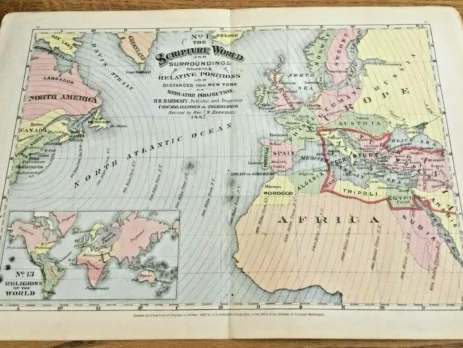Digital Storytelling with Maps: Bringing Biblical Events to Life
The Bible is more than just a collection of ancient texts; it is a tapestry of stories that have shaped cultures, beliefs, and societies for millennia. From the creation of the world to the epic journeys of biblical characters, each narrative carries profound wisdom and lessons for humanity. In the digital age, storytelling has evolved, and maps have become a powerful medium for bringing these ancient events to life. Digital storytelling with maps offers a unique and immersive experience, allowing readers to journey through the landscapes of the Bible and engage with the stories on a visual and emotional level. In this article, we will explore the art of digital storytelling with maps and its transformative impact on the way we experience and understand biblical events.
The Power of Visual Narratives
Visual narratives have a profound effect on our understanding and retention of information. Through digital storytelling with maps, biblical events are transformed from mere text to vivid visual experiences. Readers can traverse the paths of the Israelites’ exodus, follow the missionary journeys of Paul, or witness the miracles of Jesus, immersing themselves in the events as if they were there. This interactivity creates a personal connection to the stories, making them more relatable and relevant to modern audiences.
Engaging the Imagination
Digital storytelling with maps ignites the imagination and invites readers to become active participants in the biblical narratives. As readers journey through the maps, they envision the landscapes, hear the voices of the characters, and feel the emotions of the events. This imaginative engagement deepens the impact of the stories, allowing readers to internalize the lessons and teachings of the scriptures in a more profound way.
Adding Historical and Geographical Context
Maps provide a tangible sense of historical and geographical context to the biblical events. By overlaying historical data and archaeological findings onto the maps, readers gain a deeper understanding of the cultural and social factors that influenced the stories. They can see the cities, landmarks, and natural features that played significant roles in shaping the narratives. This context enriches the storytelling, making it more grounded and authentic.
Connecting with Cultural and Spiritual Significance
Digital storytelling with maps also fosters a connection with the cultural and spiritual significance of the biblical events. By incorporating relevant Bible verses, commentaries, or theological reflections, the maps become more than just visual representations; they become portals to spiritual contemplation and introspection. Readers can explore the theological themes and moral lessons conveyed by the stories, applying them to their own lives.
Making Complex Concepts Accessible
The Bible contains complex concepts and narratives that may be challenging to grasp through text alone. Digital storytelling with maps simplifies the understanding of these events, breaking them down into visually digestible segments. As readers interact with the maps, complex genealogies, journeys, and timelines become more accessible and comprehensible.
Inspiring Deeper Study and Exploration
Digital storytelling with maps serves as a springboard for deeper study and exploration of the scriptures. As readers engage with the interactive maps, they are inspired to delve further into the historical, cultural, and theological contexts of the stories. This curiosity fuels a desire for continued learning, propelling readers to explore additional resources and deepen their understanding of the Bible.
Fostering a Sense of Unity
Biblical stories have transcended time and cultural boundaries, uniting people across diverse backgrounds and beliefs. Digital storytelling with maps fosters a sense of unity among readers, regardless of their cultural or religious affiliations. The shared experience of exploring the Bible’s stories through interactive maps creates a common ground for dialogue and understanding, promoting harmony and respect among individuals and communities.
Digital storytelling with maps breathes new life into the biblical events, transforming them into captivating visual narratives that engage the imagination and connect with readers on a personal and emotional level. By providing historical and geographical context, exploring cultural and spiritual significance, and making complex concepts accessible, interactive maps offer a transformative experience of the sacred scriptures. As readers immerse themselves in the digital storytelling journey, they gain a deeper appreciation for the timeless wisdom and relevance of the Bible in shaping the human experience. Digital storytelling with maps becomes a powerful catalyst for exploration, dialogue, and spiritual growth, inviting readers to walk alongside the characters of old and find inspiration and guidance for their own lives.

